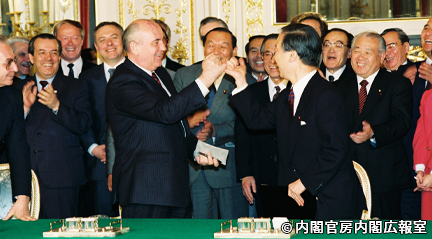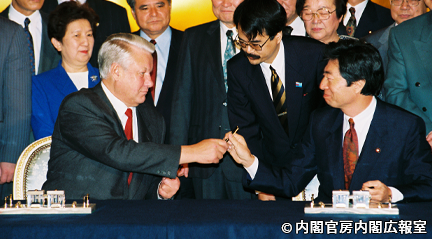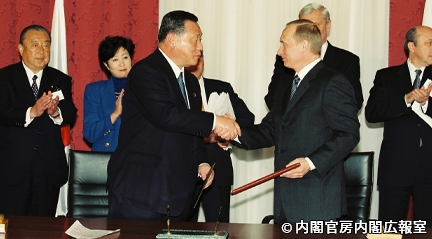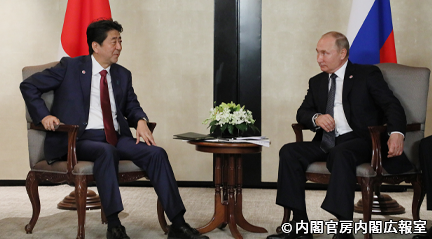
1About the Northern Territories Issue
The Northern Territories refer to the Habomai Islands, Shikotan Island, Kunashiri Island, and Etorofu Island, which are located to the northeast of the island of Hokkaido, and are inherent territories of Japan that have never held by foreign countries.
On February 7th,1855, the Treaty of Commerce, Navigation and Delimitation between Japan and Russia, which was concluded in a completely friendly and peaceful manner, confirmed the already established natural boundaries, drawing the boundary between the islands of Etorofu (the northernmost island of the Northern Territories) and Uruppu, which is located to the north of Etorofu.
However, nearing the end of the Second World War, on August 9th, 1945, the Soviet Union, in violation of the Neutrality Pact that was still in force between Japan and the Soviet Union (valid until April 1946), opened the war with Japan. Even after Japan accepted the Potsdam Declaration, Soviet forces continued its offensive against Japan and occupied all of the Four Northern Islands from 28 August 1945 to 5 September 1945.
Even though there were no Soviets on the four islands and approximately 17,000 Japanese people lived there at the time, the Soviet Union unilaterally “incorporated” the four islands into its own territories in 1946 , and had forcibly deported all Japanese residents of the Four Northern Islands by 1948.
Since then, the Soviet Union and Russia have continued to illegally occupy these territories to this day.
Because the Northern Territories issue continues to exist,a peace treaty has yet to be concluded between Japan and Russia.
Bilateral negotiations between Japan and Russia have continued to take place since then.
In order to resolve the issue of the attribution of the Four Northern Islands and to conclude a peace treaty as soon as possible, the Japanese Government intends to energetically continue negotiations with Russia on the basis of the agreements and documents created by the two sides so far.
2Position of the Hokkaido Prefectural Government Regarding the Northern Territories Issue
The Northern Territories are among the administrative areas of Hokkaido Prefecture, and the Hokkaido Prefectural Government recognizes the resolution of the Northern Territories issue as its most important administrative task, supports negotiations between Japan and Russia for an early resolution of the isuue, and strives to improve the environment for a resolution of the issue.
3History of the Northern Territories Issue (before the occurrence of the isuue)
Japan discovered and surveyed the Northern Territories before the Russians arrived there and had established effective control over the four islands by the early 19th century at the latest. In the first half of the 19th century, Russia also recognized Urup (the island located immediately north of Etorofu Island) as the southern limit of their territory in this area. The Treaty of Commerce, Navigation and Delimitation between Japan and Russia confirmed the already established natural boundaries, drawing the boundary between the islands of Etorofu and Uruppu.
In accordance with the Treaty for the Exchange of Sakhalin for the Kurile Islands, Japan received all the rights to the Kurile Islands (in this treaty, the Kurile Islands were taken to be a string of 18 islands, Shumushu Island being farthest north and Uruppu Island being the farthest to the south.) from Russia, in exchange for the cession of the rights on the island of Karafuto (Sakhalin).
The Portsmouth Peace Treaty was concluded after the end of the war between Japan and Russia and ceded to Japan from Russia the part of the Karafuto Island that lies south of the 50th degree of north latitude.
In August 1941, the leaders of the United States and the United Kingdom signed the Atlantic Charter that would serve as the guiding principles for the Allies in the Second World War, The Charter clearly set forth the principle that these two countries sought no territorial expansion by means of war.(the Soviet Union proclaimed allegiance to the Charter in September of that year).
The Cairo Declaration of 1943 affirmed this principle of the Atlantic Charter and stated that Japan would be expelled from “territories which she has taken by violence and greed” and the other territories. However, in view of the historical background, it is clear that the Four Northern Islands do not constitute territories that Japan seized “by violence and greed”.
The Potsdam Declarationstated that the terms of the Cairo Declaration which stipulated that Japan would be expelled from “territories which she had taken by violence and greed” should be carried out, and that Japanese sovereignty should be limited to the islands of Honshu, Hokkaido, Kyushu and Shikoku and such minor islands as Allies determine.
However, the Soviet Union, ignoring the Neutrality Pact that was still in force between Japan and the Soviet Union, opened the war with Japanon August 9th, 1945. The Soviet Union continued its offensive against Japan after the Potsdam Declaration was accepted by Japan and illegally occupyied the Four Northern Territories between August 28th and September 5th of that year ( Japanese army did not put any resistance to the occupation of the Northern Territories, and it was carried out without violence).
Under the San Francisco Peace Treaty, Japan renounced all right, title and claim to the Kurile Islands and the part of Sakhalin over which Japan acquired sovereignty as a consequence of the treaty of Portsmouth. However, the Four Northern Islands are not included in the Kurile Islands. Furthermore, the Soviet Union did not sign the San Francisco Peace Treaty and is not in a position to claim its rights under the Treaty.
4Key Peace Treaty Negotiations Between Japan and the Soviet Union or Russia
There was no prospect for the two countries’ reaching an agreement on the territorial issue, excluding the Habomai Islands and Shikotan Island. Therefore, the two countries signed the Japan-Soviet Joint Declaration instead of a peace treaty. The Declaration officially ended the state of war and restored diplomatic relation between them, among other provisions.
→Both parties agreed to continue peace treaty negotiations.
→The Soviet Union agreed to hand over the Habomai Islands and Shikotan Island to Japan after the conclusion of a peace treaty.
This was the first time that the Soviet Union acknowledged in writing the existence of the issue of territorial demarcation, mentioning the concrete names of the four islands.
The Tokyo Declaration
- (A)defined the territorial issue as being an issue of the attribution of the Four Northern Islands;
- (B)clearly set out that Japan and Russia should conclude a peace treaty by solving the issue of the attribution of the four islands and thereby fully normalize bilateral relations; and
- (C)set out clear negotiation guidelines; the territorial issue should be resolved (ⅰ)on the basis of historical and legal facts, (ⅱ)based on the documents to which both parties agreed, and (ⅲ)based on the principles of law and justice.
The Tokyo Declaration also confirmed that all treaties and the other international agreements between Japan and the Soviet Union continued to be applied for the relations between Japan and Russia.
- (A)This statement difined the Japan-Soviet Joint Declaration of 1956 as the starting point of the negotiating process and confirmed its legal validity in writing.
- (B)Leaders reaffirmed common recognition between Japan and Russia that, on the basis of the Tokyo Declaration, a peace treaty should be concluded by solving the issue of attribution of the four islands.
- (A)In the Joint Statement both leaders affirmed their determination to resolve the issue of the attribution of the four islands and conclude a peace treaty as soon as possible, thereby completely normalizing relations between the two countries.
- (B)The Japan-Russia Action Plan specifically mentioned the 1956 Japan-Soviet Joint Declaration, the 1993 Tokyo Declaration and the 2001 Irkutsk Statement and it was affirmed in the Action Plan that these, in condition with other agreements, were the basis for future peace treaty negotiations.
- (A)In the Joint Statement, both leaders shared their recognition that the absence of a peace treaty between Japan and Russia 67 years after the end of World War II was an unnatural state of affairs. They expressed their determination to conclude a peace treaty by overcoming the gap between their positions and finally resolving the issue (the attribution of the four islands) which was determined to the resolved both in the 2003 Joint Statement and Action Plan.
- (B)Both leaders agreed to give instruction to their respective Ministries of Foreign Affairs to accelerate the negotiations toward elaborating a mutually acceptable solution of the peace treaty issue.
As a result of candid and extremely in depth discussions over a long period of time on the issue of peace treaty between only the leaders, the two they expressed their sincere determination to resolve this issue.
Based thereon, they agreed to commence discussions on conducting joint economic activities on the Four Northern Islands under a special arrangement.
The two leaders agreed to “accelerate negotiations on a peace treaty on the basis of the Japan-Soviet Joint Declaration of 1956.”
The two leaders confirmed that they would firmly work on the peace treaty negotiations based on the various agreements created by the two sides so far, including the one between the two leaders in Singapore in 2018.
5Movement for the Return of the Northern Territories
The Movement for the Return of the Northern Territories is said to have been started by Ishisuke Ando, who was the Town Mayor of Nemuro at the time, when he submitted a petition to the Supreme Commander for the Allied Powers on December 1st, 1945. Since then, the voices of former inhabitants of the Northern Territories and residents of nearby Nemuro that demand the return of the Northern Territories has spread to all of Hokkaido and Japan.
February 7th of each year has been designated as Northern Territories Day, given that the Treaty of Commerce, Navigation and Delimitation between Japan and Russia, which peacefully determined the border between Japan and Russia to pass between Etorofu Island and Urup Island and clearly stipulated for the first time internationally that the Four Northern Islands belonged to Japan, was signed on February 7th, 1855.
In addition, February and August of each year are considered to be National Months of Emphasis on the Movement for the Return of the Northern Territories, and conventions, lecture meetings, panel exhibitions, and various other events are held across the country.
6Four-Island Exchange Program, Free Visits, and Visits to graves
The following 3 frameworks of visits to the Four Northern Islands are set up under the presumption that they would not impair the legal positions of Japan and the Russian Federation concerning the territorial issue.
Under Four-Island Exchange Program, mutual visits between Japanese citizens and Russian residents of the Northern Territories without a passport or a visa have been arranged in order to promote mutual understanding and contribute to the settlement of the territorial issues until the Northern Territories issue is resolved. The program has been conducted since 1992.
Free visits have been conducted on humanitarian grounds for former island residents and their family members (Japanese citizens) to visit the Northern territories in the most simplified manner. The program has been organized by the organization of former residents since 1999 with support from the Japanese government.
Visits to graves have been conducted with an identity document on humanitarian grounds. The program has been organized by the Hokkaido Prefectural Government in 52 graves in the Four Northern Islands since 1964.
7Joint Economic Activities on the Four Northern Islands
At the Japan-Russia summit meeting in December 2016, the two leaders reached mutual understanding that the commencement of consultations on joint economic activities on the Four Northern Islands can be a significant step toward the conclusion of a peace treaty.
As a result of the discussion at the Japan-Russia summit meeting in September 2017, the two leaders designated the five candidate projects* to be undertaken promptly. In 2019, waste-management experts from both sides visited the Northern Islands and the main island of Hokkaido respectively, and the first pilot tour joined by Japanese tourists to the Kunashiri and Etorofu Islands was conducted.
*(1) Joint propagation and aquaculture of marine products, (2) Greenhouse vegetable cultivation, (3) Development of tours compatible with the islands’ features, (4) Introduction of wind-power generation, and (5) Garbage Volume reduction measures.





